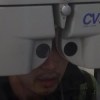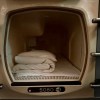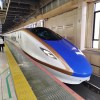Ever since the Great Tohoku Earthquake led to one of the worst nuclear disasters at the Fukushima Daiichi power plant people have been left with a lot of uncertainty. Information has not been coming from places of authority in a free and timely fashion. News broadcasts often tell stories of contaminated food and radioactive puddles near schools. Still, these stories are after the fact and often hard to process given the complex nature of radiation.
Luckily, on 27 December, Kyoto University Research Reactor Institute (KURRI) announced they are working with Fukushima Transportation Inc. to begin testing a system to monitor radiation in Fukushima City that is in real time and is accessible by anyone over the internet.
The system, named Kyoto University Radiation Mapping System or KURAMA, is ingeniously simple. First, equip buses with radiation detectors and GPS, and as they scour the city on their daily routes they can collect data from all corners of Fukushima City. The data will simultaneously be uploaded and displayed onto an online map for all to see.
If their experiment proves successful the system would most likely spread further and deeper around East Japan which in turn would provide even more accurate information. This may provide a slight but much sought after relief to the people by providing locations of so-called hotspots. Not only that, it could give researchers around the world some valuable insight to the behavior of radiation in these situations.
We applaud the efforts of KURRI and Fukushima Transportation and will continue to watch this story to report as soon as this system goes online.
Project KURAMA Info: GPS連動型放射線自動計測システム KURAMA (Japanese)

 Fukushima Prefecture Produces First Thesis on the Effects of Internal Radiation Exposure: Children of Fukushima Unaffected?
Fukushima Prefecture Produces First Thesis on the Effects of Internal Radiation Exposure: Children of Fukushima Unaffected? Radiation fears as report shows Fukushima fir trees to be growing strangely
Radiation fears as report shows Fukushima fir trees to be growing strangely New research suggests even low-level radiation in Fukushima negatively impacting wildlife
New research suggests even low-level radiation in Fukushima negatively impacting wildlife Tokyo Clinic to Test Internal Radiation Exposure
Tokyo Clinic to Test Internal Radiation Exposure New study shows wildlife thriving in areas evacuated after Fukushima nuclear meltdown【Video】
New study shows wildlife thriving in areas evacuated after Fukushima nuclear meltdown【Video】 Starbucks Japan ready to get Year of the Horse started with adorable drinkware and plushies【Pics】
Starbucks Japan ready to get Year of the Horse started with adorable drinkware and plushies【Pics】 7 great places to see Mt. Fuji from without having to climb it
7 great places to see Mt. Fuji from without having to climb it Japanese thug wear from Birth Japan perfect for those breaking bad next year
Japanese thug wear from Birth Japan perfect for those breaking bad next year We predict 7-Eleven’s new Zero Cider Triple drink is gonna be the hit drink of 2022【Taste Test】
We predict 7-Eleven’s new Zero Cider Triple drink is gonna be the hit drink of 2022【Taste Test】 We found possibly the quietest Japanese-style hotel in Tokyo’s bustling Shinjuku district
We found possibly the quietest Japanese-style hotel in Tokyo’s bustling Shinjuku district This is Japan’s, and the world’s, first capsule hotel, and you can still stay there
This is Japan’s, and the world’s, first capsule hotel, and you can still stay there Studio Ghibli unleashes Turnip Head on the world
Studio Ghibli unleashes Turnip Head on the world Is the new Shinkansen Train Desk ticket worth it?
Is the new Shinkansen Train Desk ticket worth it? Publisher reveals Japan’s favorite adults-only manga genres, by prefecture
Publisher reveals Japan’s favorite adults-only manga genres, by prefecture How to speak Japanese like a gyaru【2024 edition】
How to speak Japanese like a gyaru【2024 edition】 Lacquerware supplier to emperor of Japan and Pokémon team up for new tableware
Lacquerware supplier to emperor of Japan and Pokémon team up for new tableware Japan may add Japanese language proficiency, lifestyle classes to permanent foreign resident requirements
Japan may add Japanese language proficiency, lifestyle classes to permanent foreign resident requirements 7-Eleven Japan’s ramen-cooking robot whipped us up a bowl of noodles【Taste test】
7-Eleven Japan’s ramen-cooking robot whipped us up a bowl of noodles【Taste test】 Cyberpunk anime meets traditional culture in Ghost in the Shell gold leaf Japanese changing screens
Cyberpunk anime meets traditional culture in Ghost in the Shell gold leaf Japanese changing screens Disillusionment at Tsukiji’s tourist-target prices led us to a great ramen restaurant in Tokyo
Disillusionment at Tsukiji’s tourist-target prices led us to a great ramen restaurant in Tokyo Hello Kitty Choco Egg figures are an adorable trip through three periods of Japanese pop culture【Pics】
Hello Kitty Choco Egg figures are an adorable trip through three periods of Japanese pop culture【Pics】 Starbucks Japan releases new zodiac chilled cup drink for 2026
Starbucks Japan releases new zodiac chilled cup drink for 2026 Japan’s otoshidama tradition of giving kids money at New Year’s gets a social welfare upgrade
Japan’s otoshidama tradition of giving kids money at New Year’s gets a social welfare upgrade 7-Eleven Japan starts new temporary luggage storage service in over 300 branches
7-Eleven Japan starts new temporary luggage storage service in over 300 branches Starbucks teams up with 166-year-old Kyoto doll maker for Year of the Horse decorations【Photos】
Starbucks teams up with 166-year-old Kyoto doll maker for Year of the Horse decorations【Photos】 Tokyo considering law requiring more trash cans following litter increase in heavily touristed area
Tokyo considering law requiring more trash cans following litter increase in heavily touristed area Tokyo’s Tsukiji sushi neighborhood asks tour groups to stay away for the rest of the month
Tokyo’s Tsukiji sushi neighborhood asks tour groups to stay away for the rest of the month Nintendo’s Kirby now delivering orders at Kura Sushi restaurants, but not in Japan
Nintendo’s Kirby now delivering orders at Kura Sushi restaurants, but not in Japan Tokyo event lets you travel back in time, for free, to celebrate 100 years since Showa era start
Tokyo event lets you travel back in time, for free, to celebrate 100 years since Showa era start Sanrio theme park in Japan announces plans to expand into a Sanrio resort
Sanrio theme park in Japan announces plans to expand into a Sanrio resort Stamina-destroying “Paralysis Noodles” are Tokyo’s newest over-the-top ramen innovation
Stamina-destroying “Paralysis Noodles” are Tokyo’s newest over-the-top ramen innovation Survey asks foreign tourists what bothered them in Japan, more than half gave same answer
Survey asks foreign tourists what bothered them in Japan, more than half gave same answer Japan’s human washing machines will go on sale to general public, demos to be held in Tokyo
Japan’s human washing machines will go on sale to general public, demos to be held in Tokyo Japan’s deadliest food claims more victims, but why do people keep eating it for New Year’s?
Japan’s deadliest food claims more victims, but why do people keep eating it for New Year’s? We deeply regret going into this tunnel on our walk in the mountains of Japan
We deeply regret going into this tunnel on our walk in the mountains of Japan Studio Ghibli releases Kodama forest spirits from Princess Mononoke to light up your home
Studio Ghibli releases Kodama forest spirits from Princess Mononoke to light up your home Major Japanese hotel chain says reservations via overseas booking sites may not be valid
Major Japanese hotel chain says reservations via overseas booking sites may not be valid Put sesame oil in your coffee? Japanese maker says it’s the best way to start your day【Taste test】
Put sesame oil in your coffee? Japanese maker says it’s the best way to start your day【Taste test】 No more using real katana for tourism activities, Japan’s National Police Agency says
No more using real katana for tourism activities, Japan’s National Police Agency says Starbucks Japan reveals new sakura drinkware collection, inspired by evening cherry blossoms
Starbucks Japan reveals new sakura drinkware collection, inspired by evening cherry blossoms Updated cherry blossom forecast shows extra-long sakura season for Japan this year
Updated cherry blossom forecast shows extra-long sakura season for Japan this year First worker to die from Fukushima radiation exposure officially recognized by Japan’s government
First worker to die from Fukushima radiation exposure officially recognized by Japan’s government More than two years on, many in Japan still uncertain about food from around Fukushima
More than two years on, many in Japan still uncertain about food from around Fukushima Yes, the residents of Fukushima really are this “Happy”
Yes, the residents of Fukushima really are this “Happy” One filmmaker’s mission to show the world the real Fukushima, and how you can help
One filmmaker’s mission to show the world the real Fukushima, and how you can help Fukushima rebuilds its future with fish, tomatoes and hula-dancing girls
Fukushima rebuilds its future with fish, tomatoes and hula-dancing girls Single snake sparks power outage for nearly 10,000 homes in Fukushima
Single snake sparks power outage for nearly 10,000 homes in Fukushima
Leave a Reply